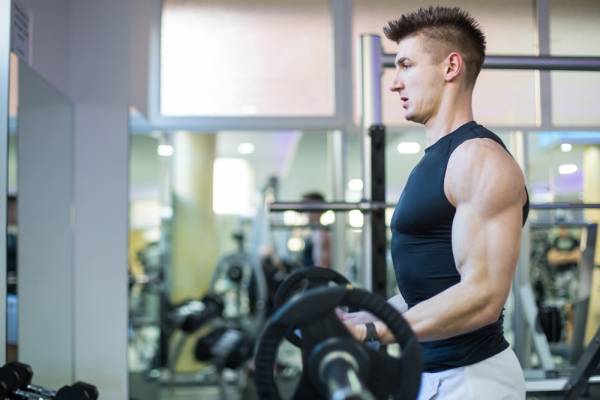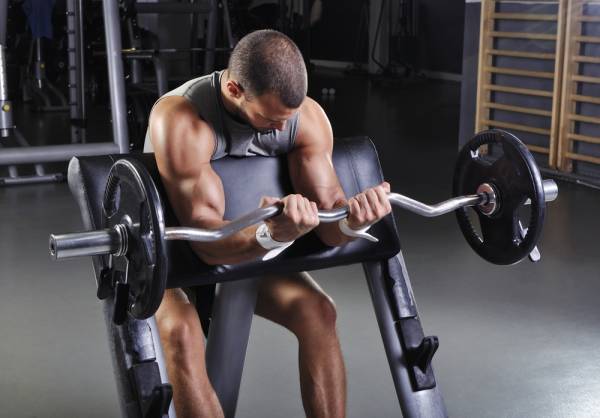Biceps curls wouldn’t appear to bother your back, but there are subtle biomechanics at play in this exercise that can hurt you in the long run. Understanding this can help you make adjustments in form and sort out which variations of the basic curl are best for you.
Since the discs and other spine structures become more vulnerable with injury and age, trainees returning from a back injury, older trainees in general, and the simply risk-adverse may find these techniques useful in avoiding further unnecessary wear and tear.
Motivation for Muscular Arms
Acquiring muscular arms is a classic motivation for fitness enthusiasts, and the curl is the obvious go-to option. The standing biceps curl has a special place for those of us who got started at home with a vinyl-covered barbell set. We may not have had a squat rack or bench, but we could put the plates on the bar and start curling right out of the box.
“I’ve found that being aware of the biomechanics behind curls (and other exercises) and adapting accordingly can really help manage that.”
The standing curl is a perfectly adequate exercise, especially at the beginning levels of strength and effort. But as we get more experienced, push harder, and become stronger, we use more weight and the curl can put an unexpected strain on the back.
“Unexpected” from the biceps curl, that is, but very expected from those who study the back:
The likelihood of problems increases if the spine is overloaded (lifting weights) when it is out of the neutral position. The spine is designed to bear loads and stresses in neutral; if it is not aligned properly those loads and stresses are transmitted unevenly and transferred to structures that were not designed for load-bearing.5
If improper posture or lifting is repeated continuously, this will fatigue or weaken the spinal structure increasing the chance of injury. The same continual exposure to force on the spine will cause general wear and tear on the spinal column as we age. This decreases the space between the vertebral bodies and allow forces on the spine to affect the nerves and spinal column, ultimately resulting in increased pain and decreased function.10
Avoid Unnecessary Pain
Conventional instruction for the basic standing curl doesn’t contradict any of this, especially with lighter weights and intentionally strict form. But as you train with heavier weights or move deeper into fatigue, there is an inevitable lean away from the weight, especially as you approach the sticking point (forearms horizontal). This results in a sway back posture, a deviation from the neutral spine, which is discouraged as a postural condition, much less with an additional load and effort through the spine.

This isn’t necessarily “cheating,” though. With your feet parallel, in line with your shoulders and hips, your base of support is a straight line in the frontal plane. As you curl the weight forward, the weight moves your center of gravity forward of that base of support, the very definition of unstable. What keeps us from face planting is the shoulders and head being drawn opposite the weight by the contraction of the deep back muscles, creating the sway back, but bringing stability to the body-barbell system. Notice, as you complete the curl, the sway back goes back to neutral. You don’t continue to bend backward when the weight is up by your shoulders.
Curling with your back against a wall doesn’t correct this, because the midway point of the curl still changes your center of gravity. Instead of your head and shoulders moving back, your hips will move forward as your body tries to regain stability.
A more effective fix is a staggered stance. By placing one foot in front of the other, you are rotating your base of support ninety degrees – front-back instead of side-to-side. The shift in center of gravity stays within your base, the body-barbell doesn’t need to regain stability, and so you maintain the neutral posture. Within the staggered stance, it also helps if you alternate curls rather than do both arms simultaneously. In effect, you reduce the total weight impacting the center of gravity.
Scott Bench Curls
The Scott bench curl , and its machine versions, stabilizes the body-barbell differently. This curl creates a cantilever – a beam that projects beyond a fulcrum, supported by a larger weight on the other side of the fulcrum. Out of gym, this design is used to provide stability without a second support, like a shelf or balcony. On the Scott bench or machine, your arm is the beam and the bench is the fulcrum. Since your bodyweight is more than the weight in your hands, curling the weight doesn’t shift the center of gravity enough to cause the sway back.

The Age Factor
You may still find some mid-to-upper back discomfort with the Scott curl and the standing curl, or for that matter any exercise with the weight held in front, even with a neutral spine. That’s because your internal center of gravity, without an external load, is always in front of your spine when your torso is vertical. What keeps your spine from falling into flexion is enough of a contraction of the deep spine muscles to hold the posture. The longer you’re upright, the longer they work.
“Obviously, if you are in sharp, stabbing, I-can’t-breathe pain, your biceps are the least of your worries.“
Add to that, any additional bodyweight you carry in front: a big chest, forward head, rounded shoulders, a big belly, plus whatever you carry in your hands. Then, you work out with the weight or kettlebell held in front of your body. Like any other muscle, the deep back muscles can get fatigued. For those of us with more years, older discs don’t absorb forces as well as younger discs, leading to a range of issues. All of which is made worse with a prior injury. So the combination of fatigued deep back muscles, older discs, and life experience may make any kind of standing or seated curl uncomfortable.
If your curl of choice or necessity is the Scott bench or machine and you want to minimize the strain on your back, do your best to keep your shoulders and head upright, to not add to the forces pulling your spine into flexion. Keep your shoulder blades down and back and your head up, even if it means using a little less weight. You may feel the biceps more directly because the body won’t be shifting part of the load to other structures for the sake of moving the weight.
Incline Curls
The back-friendliest biceps exercise may be the incline curl, either with dumbbells or machine. The bench expands your base, so the movement of the weight doesn’t affect stability. Leaning back, your internal center of gravity is no longer trying to pull your spine into flexion for your deep back muscles to have to counter. It’s also established that the reclined position with bodyweight alone puts less strain on the discs than either sitting or standing. The reclined position with lumbar support is better yet.
As far as the exact angle to set the incline, there is a reduction in disc pressure from ninety degrees, to ninety degrees with lumbar support, to 110 degrees, to 110 degrees with lumbar support, and so on, down to lying flat. So how far you get past 110 degrees is probably an individual preference. I’d suggest low enough that you don’t notice the dumbbells pulling you forward at the midpoint of the curl, but not so low that the front of your shoulders strain.
Assess Your Own Needs
Obviously, if you are in sharp, stabbing, I-can’t-breathe pain, your biceps are the least of your worries. And making these changes is no guarantee you won’t end up that way, because so many other things in and out of the gym contribute to our health and fitness.
But somewhere between wretched pain and invulnerable is a level of discomfort that’s just distracting, that may hint at problems to come, and I’ve found that being aware of the biomechanics behind curls (and other exercises) and adapting accordingly can really help manage that.
Check out these related articles:
- Respect Your Joints – Lessons Learned After My Biceps Injury
- The 2-Minute Arm Workout to Build Strong Biceps
- The Two-Jointed Muscles of the Arm – How to Train Them
- What’s New On Breaking Muscle Today
References:
1. Abrahams, Peter. The Atlas of the Human Body. (London: Amber Books, 2006).
2. DiNubile, Nicholas A. Framework for the Lower Back: a 6-Step Plan for a Healthy Lower Back. (New York: Rodale, 2010).
3. Ellison, Deborah. “Biomechanics and Applied Kinesiology,” ACE Personal Trainer Manual, edited by Cedric X. Bryant, Daniel J. Green, 6. (San Diego: American Council on Exercise, 2003).
4. Harman, Everett. “The Biomechanics of Resistance Exercise,” in Essentials of Strength Training and Conditioning, edited by Thomas R. Baechle, Roger Earle, (Champaign: Human Kinetics, 2000).
5. McGinnis, Peter. Biomechanics of Sport and Exercise. (Champaign: Human Kinetics, 1999).
6. Nordin, Margareta; Shira Schecter Weiner; adapted from Margareta Linh. “Biomechanics of the Lumbar Spine,” in Basic Biomechanics of the Musculoskeletal System, edited by Margareta, Nordin and Frankel. (Baltimore: Lippincott Williams & Williams, 2001).
8. Orndorff, Douglas G., Morgan A. Scott, and Katie A. Patty. “Force Transfer in the Spine,” Journal of the Spine Research Foundation, Vol. 7 No.2 (2010).
Photo 2 and 3 courtesy of Shutterstock.






